Zebra Swallowtail (Eurytides marcellus)
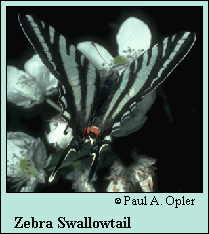
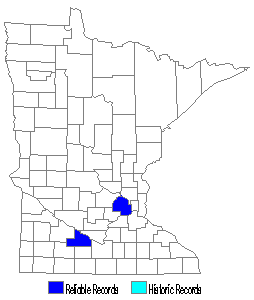
![]()
The Zebra Swallowtail
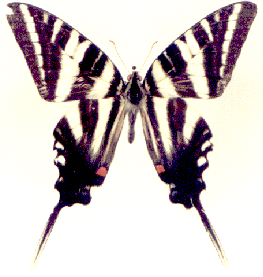
Papilio marcellus Cramer
Color: P. marcellus is a very unique species with black and white banding patterns on all four wings. The Zebra Swallowtail is not only characterized by its black and white coloration, resembling the stripes on a zebra, but by its long tails also. Spring specimens of early April are small, with short wings, short tails and restricted dark and extensive light markings (Klots, 1979, 179). The later spring and summer specimens, emerging in early June, are much larger with longer wings, somewhat heavier dark markings, and more white on the tail-tips (Klots, 1979, 179). In addition, most Zebra Swallowtails have red spots and red bands of color on lower wing surfaces (red spots located near the tails; red bands on lower wing surfaces primarily in early spring species) (Klots, 1979, 179).
Size: The Zebra Swallowtail is 3.75-4.5 inches in width (Klots, 1979, 179), and 5.0-6.5 inches in height (depending whether it is an early or late variety).
Food: The caterpillar feeds on Asimina triloba (Papaw) (Klots, 1979, 179).
Geographic Range: The Zebra Swallowtail is found from southern New England, west through southern Ontario, Michigan, Minnesota and Wisconsin, south trough central Florida and the Gulf states (Klots, 1979, 179).
![]()
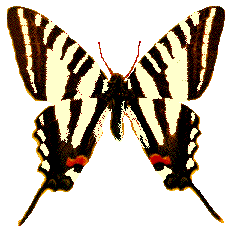
![]()
Washington Area Butterfly Club Member Articles
Zebra Swallowtail
by Mark Etheridge
The zebra swallowtail can be confused with no other butterfly in our area. Its pale greenish-white triangular wings are zebra-striped with black and accented with blue and brilliant red. It has extremely long tails, and flies in a curious ¨bat-like¨ fashion. Originally grouped with the other swallowtails in the genus Papilio, it was later renamed Graphium marcellus, a name still encountered occasionally in older books. Today it is known by the Latin name Eurytides marcellus.
This butterfly is a common resident of our low, rich woodlands from early spring until frost. It is rarely found far from its caterpillar hostplant, pawpaw (Asimina triloba ), which grows in these low woods along rivers and streams. Pawpaw is an easily recognizable deciduous shrub or small tree which may reach a height of about 40 feet at times. Its long, droopy leaves may grow to a length of twelve inches, and when bruised they produce an offensive, kerosene-like odor. After flowering in March through April, it produces an edible, fleshy fruit with several smooth, brown, flat seeds.
Zebra swallowtails in our area begin to emerge from their overwintering pupae as early as late March, but become most common in late April through May. There are usually two broods, with the early spring individuals being markedly smaller and having shorter tails than the later forms. Most reports are that the female deposits her pale green, spherical eggs singly on the lower leaves of young pawpaw trees, but at Mason Neck Regional Park in Fairfax County, Virginia I have observed that many of the early spring females prefer to oviposit on the trunks of small saplings, usually within 12¨-18¨ from the ground. A single small sapling can be observed to have several ova on it, and although I never found any young larvae, I have seen cases where many of the ova have already hatched. The larvae are most active at night, so in this instance they may have been hiding near the base of the plant during the daytime.
Males patrol the understory for females, normally flying 3´ to 6´ above the ground. Males may also be found ¨puddling¨.
John and Gloria Tveten report that the larvae are quite cannibalistic. They also report that, while the larvae are usually described as pale green, they have observed a brown variety in their studies in Texas. I have also located the brown caterpillars at Mason Neck. It has been well reported that the pupae may be either green or brown, but there appears to be no correlation between caterpillar color and pupa color. Pupation usually occurs under the leaves, and the pupae hibernate.
Adult zebra swallowtails nectar at flowers, and Paul Opler notes that the early spring individuals in our area seem to subsist mainly on blueberries, redbud, blackberry, and lilac. The later forms, he says, use common milkweed, dogbane, and vipers bugloss. They may also be seen nectaring at butterfly bush.
If you´ve not had a chance to observe this butterfly firsthand, it would be well worth seeking it out. They are quite common all along the Potomac in low woods wherever pawpaw is growing, and their habit makes it fairly easy to observe them.
Bibliography:
Brown, Melvin L. And Russel G. Brown (1972), The Woody Plants of Maryland, Port City Press, Baltimore, Maryland
Opler. Paul and George O. Krizek, (1984), Butterflies East of the Great Plains, The Johns Hopkins University Press, Baltimore and London.
Scott, James A. (1986), The Butterflies of North America: A Natural History and Field Guide, Stanford University Press, Stanford, California.
Tveten, John and Gloria (1996), Butterflies of Houston & Southeast Texas, University of Texas Press, Austin.
Mark Etheridge © 1997
![]()
If a contest were held to pick the most beautiful butterfly in Illinois, the zebra swallowtail would likely make the final four and perhaps win the coveted title. Zebra swallowtails occur in Illinois from about midway in the state to the southern tip. These inhabitants of moist, shaded woods, however, are far more common in the south. Zebra swallowtails are polymorphic, that is, they have different forms and markings depending on the season. Each spring, small brightly colored examples gracefully dart through sun-dappled woods. The larger and less colorful summer form may be seen just about anytime during the summer season. Zebra swallowtails are not large, as swallowtails go, and have a wingspan of 2.5-4.5 inches. This delicate species is black or dark brown with bright white stripes and a bright red spot at the base. A daggerlike tail graces each hind wing.
When viewed on a pin with wings spread, likely in a budding entomologist's collection, the species appears quite gaudily colored. In its native habitat, though, it is often very difficult to detect because its color pattern helps it elude predators. The same can be said about real zebras in Africa; their color patterns also help to break up their outlines and make them difficult for lions to detect. The zebra swallowtail's black and white stripes blend in remarkably well with the backgrounds present in a sunny woods, and the red spot at the base of its long tails gives predators a false head to aim at, one far removed from the insect's actual head. This increases the swallowtail's chances of surviving a bird attack by 50%.
Zebra swallowtail, Eurytides marcellus.
Adults are nectar feeders and can be seen flitting about on woodland flowers. Adults may also puddle club together--small congregations of zebras often settle on a moist spot in the forest and imbibe nitrogen left by a passing animal. Not only does puddle clubbing help zebras with their nutrition, but the clumps of colorful butterflies, almost always bachelor males, also attract the attention of a passing female.
Zebra swallowtail caterpillars feed on only one species of plant, the leaves of pawpaw, a common understory tree in many Illinois woodlands. Females appear in the forest 2 to 3 weeks before the pawpaw trees leaf out. Once the plants leaf out, the female begins to lay pea-green, spherical eggs on the upper surface of the leaves. The eggs hatch in 7-8 days. The caterpillar is pale green with yellow and black bands across its body. After 3 weeks the caterpillar is fully grown and approximately 2 inches long.
While Illinois' zebras may not be quite as large as their African counterparts, they are every bit as showy, in their own diminutive way, and form a fascinating component of Illinois woodlands.
Susan Post, Center for Economic Entomology
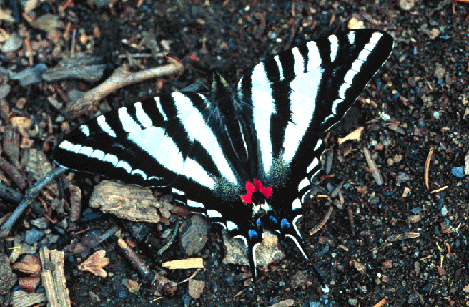
![]()
![]()
Back to Butterflies
 Wildflower
Seed For Sale
Wildflower
Seed For Sale